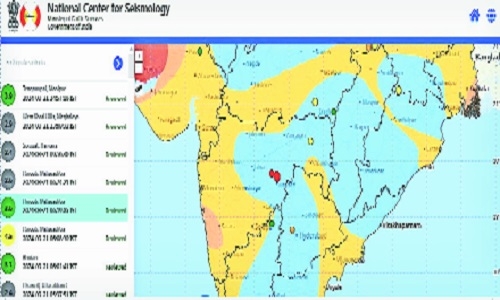Hingoli quake: ‘Safe zone’ no longer safe
| Date :22-Mar-2024 |

By Kaushik Bhattacharya
Three back-to-back earthquakes in Hingoli district of Maharashtra on Thursday created panic among citizens and raised concern among geologists about possibility of self-reactivating of deep-located fault plane. The tremors from the three earthquakes -- of magnitude 4.5 richter scale, 3.6 richter scale and 2.6 richter scale -- were also felt in Umerkhed Block-I of Umerkhed taluka of Yavatmal district. According to the website of National Seismological Center (NSC) of Ministry of Earth, Government of India, three earthquakes jolted Hingoli district at 6.08 am, 6.19 am and 6.24 am respectively. The epicentre of the 4.5 magnitude earthquake was 10 km below the earth and it took place 262 km away of South West direction from Nagpur city. Whereas, the second earthquake of 3.6 richter scale had the epicentre below 10 km and it was 262 km away from Nagpur city. The third one was 2.6 richter scale, and it happened in 5 km depth.
The first tremor was bigger than the remaining two and it was also felt in around 95 kms away in Umerkhed taluka. However, no loss of life or property were reported in Yavatmal district due to this tremors. Dr Anjan Chatterjee, former Additional Director General, Geological Survey of India (GSI) and former Director, Earthquake Geology Division, Central Region believes that the Hingoli earthquake tremors could be possibly from a deep located fault plane that could be reactivating itself. “Hingoli area has reported some mild seismic activities a few years back too. The area is otherwise in a safe earthquake Zone II like Nagpur city, denoting least susceptibility to seismicity, based on the seismic zonation map of India,” said Dr Chatterjee. “MEQ (microearthquake) recorder and macro earthquake surveys and studies could reveal more information. Therefore these studies should be conducted in Hingoli district to get the exact situation,” said Dr Chatterjee.
The Hingoli district is much like the never thought of, devastating Latur earthquake which was of 6.4 magnitude and happened on September 30 in 1993. Like Hingoli, the Latur was also considered in a safe zone and in stable continental crust and seismic zone too. The depth of its epicenter of Latur was also at about 10 kms below the surface and was due to a deep-seated fault reactivation and rupturing of the Latur Thrust Fault, explained the former ADG.“Reactivation of seismogenic faults at great depths can throw surprises and challenges too,” he warned. While talking about Nagpur city, Dr Chatterjee said, “Nagpur is also in most safe Zone II but its vicinity to the active Son Narmada South Fault (SNSF) and Gavilgarh Faults are worrisome. The SNSF fault traverses from near North Jabalpur along the bed of the Narmada river.”
The recent Seoni earthquakes also a matter of concern for Nagpur city as it is also situated near the Jabalpur where another major earthquake took place in past. “Seismically, the Seoni district of Madhya Pradesh is situated in a region where no earthquake of any significance has been traced in the past. However, the recent tremors frequently observed in and around Seoni district form a matter of study,” a senior officer of GSI, Bhopal, told ‘The Hitavada’. GSI conducted Geo Physical Study of Seoni district recently which helped to know about the status of sub-surface area of the region. It also helped to know future behavior of rocks.